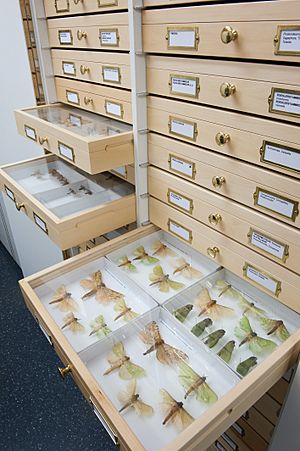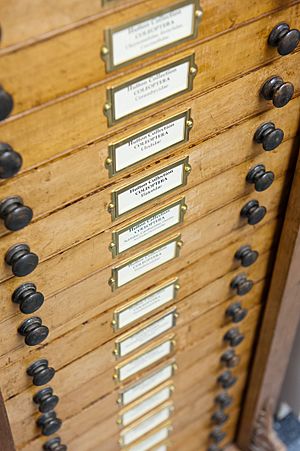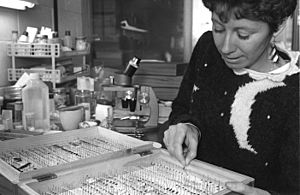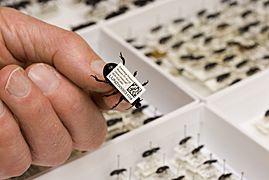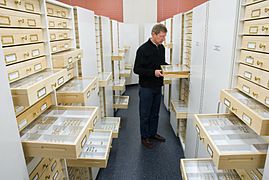Lincoln University Entomology Research Collection facts for kids
The Lincoln University Entomology Research Collection is a huge collection of about 500,000 insects, spiders, and other creatures called arthropods. These amazing specimens are kept at Lincoln University in New Zealand. It is one of New Zealand's biggest insect collections. It is also the only one found at a university.
Contents
Discovering the Collection's Past
The insect collection at Lincoln University started a long time ago. It began when the university was known as the School of Agriculture, part of Canterbury University College, back in 1880.
In the early days, a scientist named Frederick Hutton taught natural science. He was a professor at Canterbury College. Later, he became the director of the Canterbury Museum. Professor Hutton gave an insect collection to the school. Some of these original specimens and their old drawers are still part of the collection today. This gift was the very beginning of the large research collection we see now.

At first, the collection was mainly used for teaching students. It grew bigger when Roy Harrison became the first Professor of Entomology at the university. Entomology is the study of insects. Roy Harrison and another lecturer, Rowan Emberson, worked hard to get more specimens from the late 1960s onwards.
They led many summer field trips all over New Zealand. These trips helped them find new insects for the collection. Their first trip was to Mt Cook in 1969. They also visited places like the West Coast, Stewart Island, and Fiordland. They focused on areas where not many insects had been collected before. From 1969 to 1991, there were one to three trips every year. These trips helped the collection grow a lot.
The collection moved to a new building called the Hilgendorf Wing in 1968. A special room was set aside for the Entomology Museum. In 1977, Carol Muir became the curator. She was especially interested in Lepidoptera, which are moths and butterflies. After Carol Muir left in 1990, John Marris took over as curator. He is still the curator today.
What's Inside the Collection?
The collection was first called the Lincoln University Research Museum. Its main goal was to help students learn. But as it grew from all the collecting trips, it became a very important collection for research. So, in the 2010s, its name changed to reflect this. Its scientific short name is LUNZ.
In 2007, the collection moved from old wooden boxes to 1300 new glass-topped drawers. This move probably saved the collection from a lot of damage during the 2010 Canterbury earthquake.
This is the only university insect collection in New Zealand. It has over 250,000 pinned insect specimens. It also has many specimens stored in alcohol. It is one of the largest and most varied insect collections in New Zealand. It is smaller than the National Arthropod Collection but similar in size to the collections at Te Papa.
The collection is strongest in species found in the South Island, especially from the West Coast and Southern Alps. It also has collections from the Chatham Islands, Three Kings, and the subantarctic islands.
Here are some of the types of creatures the collection is especially good at:
- Spiders
- Beetles (Coleoptera), especially carabid beetles, thanks to the work of Rowan Emberson and Michael Butcher
- South Island tussock grassland moths (Lepidoptera), collected over many years by Graeme White and Carol Muir
- Parasitic wasps (Hymenoptera) from John Early's collections
- Flies (Diptera), especially from the subantarctic islands, collected by Roy Harrison
In August 2019, an amateur insect enthusiast named John Nunn gave thousands of foreign beetle specimens to the collection. These came in 100 boxes!
Special Specimens: Type Specimens
-
Dolomedes dondalei
Vink & Dupérré 2010 -
Anoteropsis cantuaria
Vink 2002 -
Creophilus rekohuensis
Clarke 2011 -
Amychus manawatawhi
Marris & Johnson 2010 -
Coptomma marrisi
Song & Wang 2003
Gallery
-
Ethanol-preserved specimens, including wētā


